Embraer ERJ family
| ERJ family ERJ135 / ERJ140 / ERJ145 | |
|---|---|
%2C_American_Eagle_AN0969536.jpg) | |
| An American Eagle ERJ-145 | |
| Role | Twin-engine Regional airliner |
| National origin | Brazil |
| Manufacturer | Embraer |
| First flight | August 11, 1995 |
| Introduction | April 6, 1997 |
| Status | In service |
| Primary users | ExpressJet Airlines Envoy Air Trans States Airlines Piedmont Airlines |
| Produced | 1992–present 2003–2016 (China) |
| Number built | 1,213 as of October 17, 2017[1] |
| Program cost | US$300 Million (1995)[2] |
| Unit cost |
US$15 Million (1996)[3] |
| Developed from | Embraer EMB 120 Brasilia |
| Variants | R-99 and P-99 Embraer Legacy 600 |
The Embraer ERJ family[lower-alpha 1] is a series of twin-engine regional jets produced by Embraer, a Brazilian aerospace company. Aircraft in the series include the ERJ135 (37 passengers), ERJ140 (44 passengers), and ERJ145 (50 passengers), as well as the Legacy business jet and the R-99 family of military aircraft. Each jet in the series is powered by two turbofan engines. The family's primary competition comes from the Bombardier CRJ regional jets.
Development
The ERJ145 was designed for a perceived new market for regional jet aircraft, where the increased speed, comfort and passenger appeal would outweigh the inherent fuel economy of the turboprop aircraft which were in service and in development.[4]
Early design

The 45–48 seat EMB145 was launched at the Paris Airshow in 1989 as an 18 ft (5.5 m) stretch of the EMB 120 Brasilia developed for $150M plus $50M for training and marketing, one third the cost of the cancelled Short Brothers FJX project. Its $11M unit cost would have been $3M less than the Canadair CRJ. The 400 kn (740 km/h) jet would be powered by GE/Garrett CFE738s, Lycoming ALF 502s or Rolls-Royce plc/Allison Engine AB580s turbofans, to be selected in the summer of 1989. It was targeted for a late 92 introduction with six produced then ramping to 60 per year in 1995. It aimed for half of a market for 1000 with break-even after twelve years with 400 sold.[5]
Keeping 75% of the Brasilia parts and systems, the EMB145 Amazon aimed for a 1991 first flight. The stretch resulted from two 11 ft (3.4 m) plugs of the 7 ft 6 in (2.29 m) diameter fuselage in the front and behind the redesigned 538 sq ft (50.0 m2) wing. Its supercritical airfoil with a 14% root thickness had its chord extended at the leading edge with a slight sweepback, increased aspect ratio and winglets. The overwing podded engines generated 6,400 lbf (28 kN) of thrust. Designed for 500–600 nmi (930–1,110 km) stages, up to 1,400 nmi (2,600 km) with a reduced payload, it had a 36,375 lb (16,500 kg) MTOW and a 21,045 lb (9,546 kg) operating empty weight.[6]
Engine Selection
In early 1990, no engine supplier willing to share the risk of the $250 million development was yet selected.[7] The Allison GMA3007 was selected in March 1990, with a maximum 40kN (7,100 lbf) take-off thrust and growth capability to 45 kN (10,000 lbf), first flight was then due in September 1991. Rolls could participate in the fan and LP turbine, its original responsibility on the RB.580 joint development.[8] By May it had 296 commitments from 19 operators, and was seeking external finance.[9] In June, maiden flight was expected by the end of 1990 before mid-1993 deliveries for $11.5 million each, cabin pressurisation was increased to 0.55 bar (8.0 psi) from the Brasilia 0.48 bar (7.0 psi).[10]
Following the engine selection, design was revised: length decreased from 27.08 to 26.74 m (88.8 to 87.7 ft), span increased from 22.37 to 22.49 m (73.4 to 73.8 ft), aspect ratio to 9.3 from 9.2. MTOW rose from 16,500 to 18,500 kg (36,400 to 40,800 lb), basic operating weight from 9,560 to 10,940 kg (21,080 to 24,120 lb), maximum fuel from 3,900 to 4,210 kg (8,600 to 9,280 lb) and payload from 4,500 to 5,160 kg (9,920 to 11,380 lb). wing loading increased from 330 to 370 kg/m2 (68 to 76 lb/sq ft), time-to-climb to FL400 gained 5 min to 30 min and maximum cruise rose from 405kt (750km/h) to 428kts (787km/h) at FL360. First delivery in 1993 was slated to Comair, which ordered 60.[11] In November 1990, a major reduction in Brazilian government spending, which held 61% of its voting share, resulted in Embraer sacking 32% of its 12,800 employees and suspending development of the EMB-145 for six months.[12]
Revised design
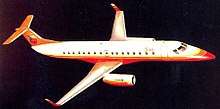
In March 1991, a revised configuration started wind tunnel testing: the quarter chord wing sweep increased to 22.3° with underslung engines for lower aerodynamic drag. This reduced the span by almost 2 to 20.5 m (6 ft 7 in to 67 ft 3 in), reducing its aspect ratio from 9.3 to 8.4 and wing area from 50 to 47 m2 (540 to 510 sq ft). The semi-monocoque wing has two main and one auxiliary spar and holds 4,500kg (9,900 lb) of fuel, it has double-slotted fowler flaps and spoilers. To accommodate the underwing engines, the landing gear is longer, allowing using jetways, and the fuselage was lengthened from 25.8 to 26 m (85 to 85 ft).[13]
In June 1991, the Brazilian Government loaned $600 million to Embraer and in July the programme was re-evaluated while tooling was 80% complete. By November 1991, Embraer which was still looking for partners to share the risk of the $350 million project, hoping to obtain Government approval by the end of the year. Sold at $12 million with an all-digital cockpit and 31.8 kN (7,100 lbf) engines, it had letters of intent for 337 units. First flight slipped to 1992 and certification for late 1993.[14]
Definitive design
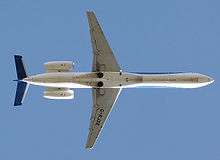
_(6983751319).jpg)
After re-evaluation late in 1991, the layout was revised again with two rear-fuselage-mounted engines and a Mach 0.8 cruise speed would be tested in the wind tunnel. Seat pitch is 79 cm (31 in). A further stretch to 50–55 passengers is limited by a 12° rotation angle. Embraer continued to look for partners to share the $350 million development as first flight was expected for late 1994.[15] In December 1994, Embraer was privatised for 80% to Brazilian and US investors while 20% was kept by the Brazilian Government.[16]
It first flew on August 11, 1995 with 18 firm orders, 16 options and 127 letters of intent. A 1,300h flight-test programme for the prototype and three pre-series aircraft (excluding two ground-test airframes) was planned within 13 months for certification in the third quarter of 1996, before deliveries in the fourth quarter of 1996 to launch customer Flight West. The $14.5 million aircraft is developed with risk-sharing partners including Spain's Gamesa producing the wing; Chile's Enaer for the tail; and the USA's C&D Interiors equipping the cabin. The standard maximum ramp weight is 19,300 and 20,300 kg (42,500 and 44,800 lb) for the extended-range, it is fitted with Honeywell Primus 2000 integrated avionics.[16]
The estimated $300 million development cost is divided between Embraer for 34%, risksharing partners for 33% (including Belgium's SONACA supplying centre and rear fuselage sections, doors, engine pylons and wing leading-edges), long-term loans from Brazilian development-funding institutions for 23% and participating suppliers for 10%. On both 370km (200nm) hubfeeder and 1,100km hub-bypass sectors, the EMB145 was expected to offer lower operating costs than the similarly priced Saab 2000 high-speed turboprop and the CRJ.[2] Its $15 million price was $4 million lower than the CRJ.[17]
The Flight Test campaign took four aircraft: S/N 801, PT-ZJA, S/N 001, PT-ZJB, S/N 002, PT-ZJC and S/N 003, PT-ZJD. Only S/N 003 was fitted with passenger seats and had no FTI (flight test instrumentation) and was used for functional and reliability tests.
In July 1996, its certification was targeted for October. First delivery was planned for late November, 29 aircraft were to be produced in 1997, 38 in 1998 and at least 48 a year thereafter. Its MTOW could be raised from the standard 19,200 to 20,600 kg (42,300 to 45,400 lb) for an Enhanced Range version.[3] Flight tests allowed to increase its cruise speed to Mach 0.78 from 0.74, and showed fuel economy was 7% better than predicted.[18] Before the Summer 1996 Farnborough Airshow, Embraer held 62 firm orders and 218 options.[19] Continental Express then purchased 25 EMB145s and took 175 options.[20] More than 50 seats would need a wider fuselage for four-abreast seating, an enlarged wing and a more powerful turbofan.[21]
It was approved by the FAA on December 10, 1996.[22]
Embraer delivered 892 units of all variants through 2006, and predicted that another 102 units would be delivered in the 2007–2016 time period.[23]
Production in China
In 2003, Embraer entered a partnership with the Harbin Aircraft Industry Group of Harbin, China. The resulting joint-venture company Harbin Embraer Aircraft Industry began producing the ERJ145 for the Chinese market by assembling complete knock down kits prepared by other worldwide Embraer operations. After 13 years, its last delivery was in March 2016; more than 40 ERJ145 and 5 Embraer Legacy 650 were assembled.[24]
Shortened versions
Embraer has introduced two shortened versions of the ERJ145. All three aircraft share the same crew type rating, allowing pilots to fly any of the three aircraft without the need for further training.
The ERJ140 is 1.42 metres (4.7 ft) shorter, seating 44 passengers, and has 96% parts commonality with the ERJ145. The only significant changes are a shorter fuselage, a slightly derated engine and an increased range. The ERJ140 was designed with fewer seats in order to meet the needs of some major United States airlines, which have an agreement with the pilots' union to limit the number of 50-seat aircraft that can be flown by their affiliates. At launch, Embraer estimated the cost of an ERJ140 to be approximately US $15.2 million. The estimated cost of development of the ERJ140 was US $45 million.
The ERJ135 is 3.54 metres (11.6 ft) shorter, seating 37 passengers, and has 95% parts commonality with the ERJ145. The first ERJ135 entered service in 1999.
Design
The airframe is mainly stretched, machined and chemically milled aluminium, with CFRP for moving parts, GFRP for fairings and sidewalls, kevlar for leading edges and Nomex honeycomb-CFRP/GFRP sandwiches for floors.[2]
Engine
The EMB145 family of aircraft generally come equipped with two Rolls-Royce AE 3007 series turbofan engines. The engines have a bypass ratio of 5:1. The engines are controlled by two FADECs (Full Authority Digital Engine Controls). The FADECs control virtually all aspects of the engine and send engine data to be displayed on the EICAS for the pilot.
Avionics
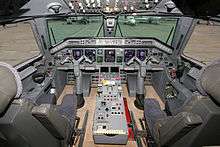
The Embraer ERJ145 family of aircraft typically comes equipped with the Honeywell Primus 1000 avionics suite. The suite normally consists of five CRT display units (DUs) or screens. From left to right, the system consists of a Primary Flight Display (PFD), Multi-Function Display (MFD), Engine Indication and Crew Alerting System (EICAS), Multi-Function Display (MFD) (Co-pilot) and Primary Flight Display (PFD) (Co-pilot). The DUs are normally CRTs but can be upgraded to lighter LCD displays. These upgraded DUs also have added functionality.
Operational history
_JP7008157.jpg)
The first delivery was in December 1996 to ExpressJet Airlines (then the regional division of Continental Airlines flying as Continental Express). ExpressJet is the largest operator of the ERJ145, with 270 of the nearly-1,000 ERJ145s in service. The second largest operator is Envoy Air, with 206 ERJ145 aircraft. Trans States operates 47 ERJ145s through alliances with United Express and Envoy Air. Piedmont Airlines also operates 40 ERJ145s through an alliance with American Airlines.
The ERJ140 was introduced in September 1999, first flew on June 27, 2000 and entered commercial service in July 2001. Envoy Air, the regional jet subsidiary of American Airlines flying as American Eagle, operates the majority of the ERJ140s built, including the first to be delivered (N800AE). As of early 2005, 74 ERJ 140s had been delivered. This version is marketed as ERJ140, but on the company's internal documents and on Federal Aviation Administration certification, the version is designated EMB 135KL. In March 2007 ExpressJet entered into a short-term agreement to operate some regional routes for JetBlue Airways using its ERJ145 aircraft.
In May 2017, the ERJ135 was leased $33,000 to $43,000 per month ($396,000 to $516,000 per year) and the ERJ145 $38,000 to $55,000 per month ($456,000 to $660,000 per year).[25]
As of 18 March 2018, the Embraer ERJ family was involved in 24 incidents for 8 hull losses without any fatalities.[26]
Variants
Civilian models
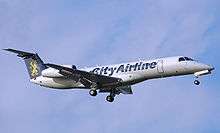
_Mar_2006.jpeg)
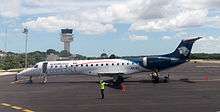
- ERJ135ER – Extended range, although this is the baseline 135 model. Simple shrink of the ERJ145, seating thirteen fewer passengers, for a total of 37 passengers.
- ERJ135LR – Long Range – increased fuel capacity and upgraded engines.
- ERJ140ER – Simple shrink of the ERJ145, seating six fewer passengers for a total of 44 passengers.
- ERJ140LR – Long Range (increased fuel capacity (5,187 kg) and upgraded engines.
- ERJ145STD – The baseline original, seating for a total of 50 passengers.
- ERJ145EU – Model optimized for the European market. Same fuel capacity as 145STD (4,174 kg) but an increased MTOW[27] 19,990 kg
- ERJ145ER – Extended Range, although this is the Baseline 145 model.
- ERJ145EP – Same fuel capacity as 145ER (4,174 kg) but an increased MTOW 20,990 kg.
- ERJ145LR – Long Range – increased fuel capacity (5,187 kg) and upgraded engines.
- ERJ145LU – Same fuel capacity as 145LR (5,187 kg) but an increased MTOW 21,990 kg.
- ERJ145MK – Same fuel capacity (4,174 kg), landing weight (MLW) and MTOW as in the 145STD, but a changed MZFW[28] (17,700 kg).
- ERJ145XR – Extra-long Range (numerous aerodynamic improvements, including winglets, strakes, etc. for lower cruise-configuration drag; a ventral fuel tank (aft location) in addition to the two main larger capacity wing tanks (same tanks as in the LR models); increased weight capacity; higher top speed and up-rated engines.
- Legacy 600 (EMB135BJ) – Business jet variant based on the ERJ135.
- Legacy 650 (EMB135BJ) – Business jet variant based on the ERJ135.
- Harbin Embraer ERJ145 – joint venture with Harbin Aircraft Manufacturing Corporation
The physical engines are the same (Rolls-Royce AE 3007), however, the FADEC (Full Authority Digital Engine/Electronic Control) logic is what differs between the various models in regards to total thrust capability.
The extended range version, the ERJ 145ER, has Rolls Royce AE 3007A engines rated at 31.3 kN(7,036 lb) thrust, with the option of more powerful AE 3007A1 engines. A, A1, A1P models are mechanically identical but differ in thrust due to variations in FADEC software. The A1E engine, however, has not only new software, but significantly upgraded mechanical components.
The long-range ERJ 145LR aircraft is equipped with Rolls Royce AE 3007A1 engines which provide 15% more power. The engines are flat rated at 33.1 kN (7,440 lb) thrust to provide improved climb characteristics and improved cruise performance in high ambient temperatures.
The extra-long-range ERJ 145XR aircraft is equipped with Rolls-Royce AE 3007A1E engines. The high performance engines provide lower specific fuel consumption (SFC) and improved performance in hot and high conditions. The engines also yield a higher altitude for one-engine-inoperable conditions."[29] CommutAir, ExpressJet and Trans States Airlines are the only operators of the ERJ 145XR. February 2011 Embraer presented its new EMB-145 AEW&C for India.
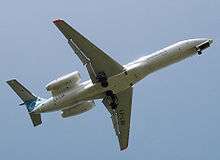
Despite the multiple variants, pilots need only one type rating to fly any variant of the ERJ aircraft. Companies like American Eagle and ExpressJet Airlines utilize this benefit with their mixed fleet of ERJ135ER/LR and ERJ145EP/LR/XR. Shared type ratings allows operators to utilize a single pilot pool for any ERJ aircraft.
Military models
- C-99A – Transport model
- EMB 145SA (R-99A) – Airborne Early Warning model
- EMB 145RS (R-99B) – Remote sensing model
- EMB 145MP/ASW (P-99) – Maritime patrol model
- EMB 145H (Hellenic Air Force) – Airborne Early Warning model
- EMB 145I (Indian Air Force) – Airborne Early Warning model
Operators
Civilian operators
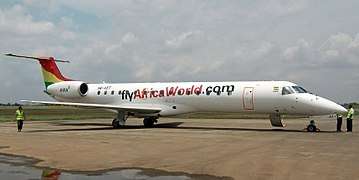
.jpg)
As of February 2018, the main civilian operators with ten units or more are:
- Airlink: 21
- CommutAir: 29
- ExpressJet Airlines: 112
- Envoy Air: 90
- Flybmi: 18
- HOP!: 17
- Piedmont Airlines: 52
- TAR Aerolineas: 11
- Tianjin Airlines: 17
- Trans States Airlines: 56
Military operators
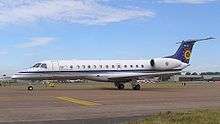
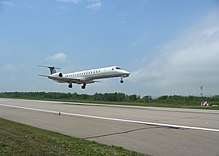
- Belgian Air Component (operates two ERJ135 and two ERJ145 since 2001 in passenger transport and VIP roles)
Notable accidents
- On February 11, 1998 a Continental Express ERJ-145ER registered N14931 crashed on takeoff at Jefferson County Airport in Beaumont, Texas during a training flight. The NTSB reported that after the incorrect application of rudder during a V1 cut maneuver, the left wing stalled. The aircraft was damaged beyond repair.
- On December 28, 1998, a Rio-Sul flight crew, approaching Curitiba, Brazil's Afonso Pena Airport, descended beyond the normal rates and landed at a speed significantly higher than the normal landing speed. The aircraft tail section cracked and was dragged along the runway.[31] The aircraft involved, an ERJ 145ER registered as PT-SPE, was damaged beyond economical repair.
- On September 29, 2006, an ExcelAire Embraer Legacy EMB 135BJ, Civil Registration N600XL[32], collided with Gol Transportes Aéreos Flight 1907, a Boeing 737-800, while flying over the northern state of Mato Grosso en route to Manaus from São José dos Campos. The Legacy made an emergency landing at Cachimbo Airport near Serra do Cachimbo, Pará, Brazil, with significant damage and with its 5 passengers and 2 crew members uninjured. The Gol 737 crashed in the Amazon forest east of Peixoto de Azevedo, killing all 148 passengers and 6 crew members.[33]
- On 7 December 2009, an ERJ135 operated by South African Airlink (registration:ZS-SJW) on a scheduled flight SA-8625 from Cape Town, overshot the runway when trying to land in wet weather at George Airport; no fatalities were reported. It was determined that the aircraft touched down in the area of the fourth landing marker. According to the air traffic controller (ATC) on duty at the time, the landing appeared normal, however the aircraft did not vacate the runway but instead veered to the right and slid past the ILS localizer. The aircraft collided with eleven approach lights and burst through the aerodrome's perimeter fence; it came to rest in a nose-down attitude on a public road. A preliminary investigation showed that the landing gear tyres did display some evidence of aquaplaning. The plane was damaged beyond economical repair.
- On August 25, 2010, an ERJ145 operated by Passaredo, crash-landed on approach to Vitória da Conquista. The plane touched-down short of the runway and the crew lost control, resulting in the aircraft sustaining severe damage before coming to a stop away from the runway. Two of the 27 people on board were injured. The airline said the plane was unable to lower landing gear, although observers said the landing gear was lowered while the aircraft was landing.[34]
- On September 4, 2011, a United Express Embraer 145 slid off the runway upon landing at Ottawa Macdonald–Cartier International Airport in Ottawa, Ontario, Canada. All 44 passengers aboard were uninjured. The plane sustained substantial damage to its gear and wing on the right-hand side; it was damaged beyond economic repair.
- On December 22, 2017, a BMI Embraer 145 left the runway at Bristol Airport when taxiing after landing from Frankfurt. There were no injuries, but the runway was closed for several hours. Problems were caused because of this being the busiest day of the pre-Christmas period at the airport.[35]
Specifications

| Variant | ERJ135[36][37] | ERJ140[38][39] | ERJ145 LR[40][41]/ XR[42][43] |
|---|---|---|---|
| Crew | 3 (2 pilots + flight attendant) | ||
| Seating | 37 | 44 | 50 |
| Length | 26.33 m (86 ft 5 in) | 28.45 m (93 ft 4 in) | 29.87 m (98 ft 0 in) |
| Wing span | 20.04 m (65 ft 9 in) | ||
| Height | 6.76 m (22 ft 2 in) | ||
| MTOW | ER: 19,000 kg (41,887 lb) LR: 20,000 kg (44,092 lb) |
ER: 20,100 kg (44,312 lb) LR: 21,100 kg (46,517 lb) |
LR: 22,000 kg (48,501 lb) XR: 24,100 kg (53,131 lb) |
| BOW | ER: 11,402 kg / 25,137 lb LR: 11,501 kg / 25,355 lb |
ER: 11,816 kg / 26,049 lb LR: 11,808 kg / 26,032 lb |
LR: 12,114 kg / 26,706 lb XR: 12,591 kg / 27,758 lb |
| Max payload | ER: 4,198 kg (9,255 lb) LR: 4,499 kg (9,918 lb) |
ER: 5,284 kg (11,649 lb) LR: 5,292 kg (11,666 lb) |
LR: 5,786 kg (12,755 lb) XR: 5,909 kg (13,027 lb) |
| Fuel capacity | ER: 5,146l / 1,359gal, LR: 6,396l / 1,690gal, XR: 7,438l / 1,965gal | ||
| Engines (2x) | ER: AE 3007-A3 / LR: -A1/3 | AE 3007-A1/3 | LR: AE 3007-A1 / XR: -A1E |
| Takeoff Thrust | A3: 33.71 kN / 7580 lbf; A1, A1/3 : 33.71 kN / 7580 lbf; A1E: 39.67 kN / 8917 lbf[44] | ||
| Maximum cruise | Mach 0.78 (450 kn; 833 km/h) / 145XR: Mach 0.8 (461 kn; 854 km/h) | ||
| Service ceiling | 37,000 ft / 11,278m | ||
| Range | ER: 1,300 nmi (2,400 km) LR: 1,750 nmi (3,240 km) |
ER: 1,250 nmi (2,320 km) LR: 1,650 nmi (3,060 km) |
LR: 1,550 nmi (2,870 km) XR: 2,000 nmi (3,700 km) |
See also
Related development
Aircraft of comparable role, configuration and era
Related lists
References
- Notes
- ↑ ERJ or Embraer Regional Jet is a marketing name. The type is officially the Embraer EMB 135 and EMB 145.
- ↑ "Embraer 135/145 Production summary - Airfleets aviation". www.airfleets.net.
- 1 2 3 Graham Warwick (18 October 1995). "Brazil's budget jet". Flight International. p. 59.
- 1 2 Peter Henley (3 July 1996). "Basic appeal". Flight International. p. 29.
The EMB-145 is not an innovative aircraft, but Embraer's attention to basics makes it pleasant to fly.
- ↑ Resende, O.C. The evolution of the aerodynamic design tools and transport aircraft wings at Embraer, J. Braz. Soc. Mech. Sci. & Eng. vol.26 no.4 Rio de Janeiro Oct./Dec. 2004 Retrieved 8 November 2015.
- ↑ "Embraer launches regional jet". Flight International. 24 June 1989. p. 6.
- ↑ "Amazon lines up". Flight International. 1 July 1989. p. 19.
- ↑ "FAMA delays Embraer CBA-123". Flight International. 7 February 1990. p. 39.
- ↑ "Allison to power Embraer 145". Flight International. 14 March 1990.
- ↑ "Embraer sees EMB.145 options grow". Flight International. 2 May 1990. p. 14.
- ↑ "Regional aircraft directory". Flight International. 13 June 1990. p. 68.
- ↑ "Allison improves Embraer's 145". Flight International. 27 June 1990. p. 22.
- ↑ "Workforce cut as Embraer suspends EMB-145 plan". Flight International. 7 November 1990. p. 4.
- ↑ Guy Norris (27 March 1991). "Embraer tests new 145 as Vector takes to air". Flight International. p. 18.
- ↑ "Regional aircraft directory". Flight International. 6 November 1991. p. 44.
- ↑ "Regional airliner directory". Flight International. 10 June 1992. p. 72.
- 1 2 "Embraer flies EMB-145". Flight International. 23 August 1995. p. 5.
- ↑ Doug Cameron (21 August 1996). "Embraer claims US launch customer". Flight International. p. 6.
- ↑ "Embraer increases EMB-145 cruise speed". Flight International. 10 July 1996. p. 3.
- ↑ Max Kingsley-Jones (28 August 1996). "Regional rivalry". Flight International. p. 90.
The Embraer EMB-145's Farnborough debut will help to focus attention on regional airliners.
- ↑ "Continental lifts Embraer into regional record book". Flight International. 11 September 1996. p. 10.
- ↑ "Embraer evaluates next regional developments". Flight International. 18 September 1996. p. 14.
- ↑ "Type Certificate data sheet T00011AT" (PDF). FAA. September 28, 2015.
- ↑ "Embraer ERJ 135/140/145". Aviation Week & Space Technology. 29 October 2007. p. 66.
- ↑ Trautvetter, Chad (6 June 2016). "Embraer To Close Legacy 650 Assembly Facility in China". AINonline. Retrieved 7 June 2016.
- ↑ Collateral Verifications LLC (May 2017). "myairlease FleetStatus".
- ↑ "Embraer 145 Statistics". ASN Aviation Safety Database. 18 March 2018.
- ↑ MTOW – Maximum take-off weight
- ↑ MZFW – Maximum zero-fuel weight
- ↑ Aerospace-Technology.com ERJ145
- ↑ "Embraer Signs Contracts with the Royal Thai Army and the Royal Thai Navy" (Press release). São José dos Campos: Embraer. 5 November 2007. Retrieved 3 December 2008.
- ↑ Flight recorder video of Rio-Sul incident YouTube. Retrieved July 18, 2007.
- ↑ "FAA Registry (N600XL)". Federal Aviation Administration.
- ↑ Harro Ranter (29 September 2006). "ASN Aircraft accident Embraer EMB-135BJ Legacy 600 N600XL Novo Progresso-Cachimbo Air Base, PA (SBCC)". aviation-safety.net. Retrieved 25 January 2015.
- ↑ "Accident: Passaredo E145 at Vitoria da Conquista on Aug 25th 2010, landed short of runway". The Aviation Herald. 26 August 2010. Retrieved 28 August 2010.
- ↑ "BMI, easyJet and Ryanair flight arrivals and departures into Bristol Airport delayed and diverted after plane leaves runway". Bristol Post. 22 December 2017. Retrieved 22 December 2017.
- ↑ "E135 Weights" (PDF). Embraer. June 2013. Archived from the original (PDF) on 2014-11-29.
- ↑ "E135 Performance" (PDF). Embraer. June 2013. Archived from the original (PDF) on 2014-11-29.
- ↑ "E140 Weight" (PDF). Embraer. June 2013. Archived from the original (PDF) on 2014-11-29.
- ↑ "E140 Performance" (PDF). Embraer. June 2013. Archived from the original (PDF) on 2014-11-29.
- ↑ "E145 LR Weight" (PDF). Embraer. June 2013. Archived from the original (PDF) on 2014-11-29.
- ↑ "E145 LR Performance" (PDF). Embraer. June 2013. Archived from the original (PDF) on 2014-11-29.
- ↑ "E145 XR Weight" (PDF). Embraer. June 2013. Archived from the original (PDF) on 2014-11-29.
- ↑ "E145 XR Performance" (PDF). Embraer. June 2013. Archived from the original (PDF) on 2015-09-24.
- ↑ "Rolls-Royce AE3007" (PDF). type certificate data sheet. EASA. 5 May 2015.
- Bibliography
- ERJ145 information at Airliners.net
- Embraer Legacy Super Mid-Size Corporate Jet Aerospace-Technology website
- Information on Harbin Embraer
- EMB-145 Press Release for Rio-Sul Crash
- Endres, Gunter and Gething, Mike. (2002). Aircraft Recognition Guide, (2nd Ed.). New York: Harper Collins Publishers. ISBN 0-00-713721-4
- Aviation Week & Space Technology, 29 October 2007 issue, p. 66
- New Embraer-145 AEWC for India
External links
| Wikimedia Commons has media related to Embraer ERJ family. |